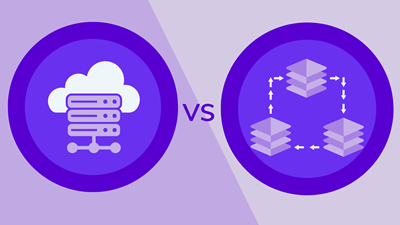What's the Difference Between Cloud Hosting and CDN?


Users expect fast and seamless browsing experiences despite their location or the device they are using. A slow website can result in frustration and abandonment, leading to missed business opportunities. Additionally, search engines prioritize fast-loading websites, making performance a critical factor for optimization (SEO) and organic visibility.
While cloud hosting provides a robust infrastructure for hosting websites and applications, Content Delivery Networks (CDNs) focus on content delivery optimization. For best results, organizations can utilize a combination of cloud hosting and CDNs to deliver powerful performance enhancements. But before doing so, it’s essential to know what these two networks offer.
This article will explore how CDNs and cloud hosting work, how they differ, and how to leverage these tools for maximum gains.
What is Cloud Hosting?
Cloud hosting is the hosting of websites and applications on virtual servers that pull resources from a network of real servers that are networked. Unlike traditional hosting methods that rely on a single physical server, cloud hosting leverages the power of multiple servers, providing scalability, flexibility, and reliability.
Service models: IaaS, PaaS, and SaaS
Cloud hosting is offered through various service models, each catering to different infrastructure management and customization levels. The three primary service models in cloud hosting are Infrastructure as a Service, Platform as a Service, and Software as a Service.
- Infrastructure as a Service (IaaS) provides businesses with the fundamental building blocks of cloud infrastructure, including virtual machines, storage, and networking capabilities. With IaaS, companies have complete control over the operating system, software installations, and configurations. This model is well-suited for developers and businesses that require maximum control and flexibility over their hosting environment.
- Platform as a Service (PaaS) offers a higher abstraction than IaaS. PaaS providers offer a complete development and deployment platform, including runtime environments, development tools, and pre-configured services. With PaaS, businesses can focus on application development and deployment without worrying about infrastructure management. This model mainly benefits developers seeking rapid application development and deployment capabilities.
- Software as a Service (SaaS) is the highest level of abstraction in cloud hosting. With SaaS, businesses utilize software applications hosted and managed by a cloud provider. Users can access these applications through web browsers, eliminating the need for local installations. SaaS offers simplicity and convenience, as businesses can leverage ready-to-use software solutions without needing infrastructure management or software maintenance.
Benefits of Cloud Hosting
Cloud hosting has become a game-changer for professionals and organizations involved in website development, offering a range of benefits that set it apart from traditional hosting methods. It is crucial to understand these benefits to make informed decisions when choosing the right hosting solution.
This section will highlight the key advantages of cloud hosting, as follows:
Scalability
Businesses may instantly scale up or down their resources with cloud hosting based on their needs. Additional server resources can be allocated dynamically during high traffic or increased demand to ensure optimal performance. Conversely, during periods of low traffic, resources can be scaled back, allowing businesses to optimize costs and avoid unnecessary expenses.
Reliability
Reliability is a critical factor in website hosting. Downtime can be detrimental to businesses, resulting in lost revenue and damage to brand reputation. Cloud hosting excels in terms of reliability due to its distributed network of servers.
Unlike traditional hosting methods, which rely on a single physical server that may be susceptible to hardware failures or downtime, cloud hosting distributes data and applications across multiple servers. This distributed architecture ensures that even if one server fails, the website or application remains accessible as resources are seamlessly shifted to other available servers.
This redundancy significantly reduces the risk of downtime and provides a reliable hosting environment for businesses.
Cost-effectiveness
Cost-effectiveness is another significant advantage of cloud hosting. Traditional hosting methods often involve upfront investments in hardware, infrastructure, and maintenance costs. This can be a substantial financial burden, especially for small businesses or startups with restricted budgets.
Cloud hosting operates on a pay-as-you-go model, allowing businesses to pay only for the resources they utilize. Instead of investing in physical servers and infrastructure, companies can leverage the resources of cloud hosting providers. This eliminates the need for upfront capital expenditure and reduces ongoing maintenance costs.
Additionally, cloud-based servers offer the flexibility to scale resources up or down based on demand, providing businesses optimize their costs by paying for what they need.
What is Content Delivery Network (CDN)?
A Content Delivery Network (CDN) is a geographically distributed network of servers strategically placed worldwide. It aims to deliver web content, such as images, videos, scripts, and static files, to end-users with maximum speed and efficiency.
When a user visits a website, the CDN identifies the user's location and serves the range from the server closest to the user. This proximity minimizes the latency and network congestion when content travels long distances, leading to faster content delivery.
How CDNs work
CDNs employ various techniques to optimize content delivery and improve website performance. The following are the critical components of how CDNs work:
- Content Caching: CDNs cache website content in edge servers in different geographic regions. When a user requests content, the CDN serves it from the nearest edge server, minimizing the distance the content travels and reducing latency.
- Edge Servers: Edge servers are strategically placed servers in different locations worldwide. These servers store cached copies of website content and deliver content to end-users. By having edge servers closer to the users, CDNs minimize the physical distance data travels, resulting in faster content delivery.
- Load Balancing: CDNs employ load-balancing techniques to distribute user requests across multiple edge servers. This ensures that no single server becomes overwhelmed with traffic, improving overall performance and preventing performance degradation during traffic spikes.
- Performance Optimization: CDNs utilize various optimization techniques to enhance content delivery further. These include image optimization, minification of scripts and stylesheets, and file compression. By reducing the size of files and optimizing their delivery, CDNs improve page load times and user experience.
- Traffic Offloading: CDNs help offload traffic from the origin server, reducing the load on the infrastructure and improving its overall performance. CDNs handle a significant portion of the requests by delivering content from the edge servers, allowing the origin server to focus on more critical tasks.
Advantages of CDNs
Organizations can enjoy the following benefits when using CDNs:
Enhanced Performance
CDNs store copies of the website content, such as images, videos, scripts, and static files, in multiple edge servers across different geographic regions. When a user requests content, the CDN serves it from the nearest edge server, significantly reducing the time it takes to retrieve and deliver the content. CDNs reduce latency, improve page load times, and provide a faster and more responsive user experience by caching content closer to the end users.
Content caching also decreases the load on the origin server, as the CDN handles a significant portion of content delivery. This offloading of traffic improves the overall performance of the origin server, allowing it to focus on critical tasks, such as generating dynamic content or processing user requests that cannot be served from the cache. The result is an optimized infrastructure that can handle higher traffic volumes and provide a smoother user experience.
Global Reach
CDNs can reach users on a global scale, ensuring optimized content delivery to users regardless of their geographic location. With edge servers strategically distributed across different regions, CDNs can deliver content from servers closest to the end users. This proximity minimizes the physical distance content has to travel, reducing network latency and improving overall website performance.
The global reach of CDNs is particularly beneficial for websites with an international audience or businesses operating in multiple regions. Whether a user is accessing the website from North America, Europe, Asia, or any other part of the world, CDNs ensure fast and efficient content delivery, enabling a consistent and positive user experience across different geographical locations.
Load Balancing
CDNs employ load-balancing techniques to distribute user requests across multiple edge servers. This load balancing ensures that no single server becomes overwhelmed with traffic, maintaining high availability and optimal performance.
By intelligently distributing traffic, CDNs ensure that user requests are efficiently handled, reducing the risk of server overloads and preventing performance degradation during traffic spikes. Load balancing also enhances fault tolerance, as CDNs can automatically redirect requests to an alternative server if one server becomes unavailable or experiences issues.
CDN vs. Cloud Hosting: What’s the Difference?
As mentioned earlier, cloud hosting services and CDNs offer distinct value propositions for organizations using them. This section will compare these two based on their focus, geographical distribution, and scope of optimization.
Infrastructure Focus vs. Content Delivery Focus
Cloud hosting primarily provides infrastructure and hosting services for websites and applications. It utilizes virtual servers and storage resources located in centralized data centers. With cloud hosting, businesses can access and manage their resources remotely via the Internet. This infrastructure-centric approach offers flexibility, scalability, and cost-effectiveness by allowing companies to pay for the resources they use.
On the other hand, CDNs have a content delivery focus. They are geographically distributed networks of servers strategically placed around the world. Their primary purpose is to deliver website content, such as images, videos, scripts, and static files, to end-users with optimal speed and efficiency. CDNs achieve this by caching content in edge servers closer to the end users.
Geographical Distribution: Central Data Centers vs. Edge Servers
A critical distinction between cloud hosting and CDNs is their geographical distribution models. Cloud hosting primarily relies on central data centers, which are centralized locations where the hosting infrastructure is located. These data centers house the servers, storage devices, and networking equipment to run and manage the hosted websites and applications. Cloud hosting providers often have multiple data centers in different regions to ensure redundancy and disaster recovery.
In contrast, CDNs utilize edge servers strategically placed in various geographical locations. They leverage their distributed network of edge servers to deliver content from the nearest server to the requesting user. By bringing content closer to the users, CDNs overcome the limitations of long-distance data transmission and network congestion, resulting in faster and more reliable content delivery.
Scope of Optimization: Overall Infrastructure vs. Specific Content Delivery
Cloud hosting empowers businesses with the flexibility to scale resources up or down based on their specific needs, ensuring optimal resource utilization. Moreover, reputable cloud hosting providers offer robust management tools, monitoring capabilities, and automatic scaling features to optimize the performance of the entire infrastructure.
In contrast, CDNs specialize in the specific optimization of content delivery. They are designed to deliver website content, including images, videos, scripts, and static files, to end-users as swiftly and efficiently as possible through strategically-placed edge servers. They also employ techniques such as image optimization, minification, and file compression to optimize further the specific content being delivered.
Synergies Between Cloud Hosting and CDN
Despite their differences, cloud infrastructure and CDN go hand in hand in optimizing websites and content delivery. Organizations can harness the strengths of these two networks and achieve the best of both worlds.
Here are 3 great reasons why you should integrate cloud hosting and CDN into your web strategy:
Complementary Roles for Website Optimization
Cloud hosting and CDNs work synergistically to optimize different aspects of website delivery. It ensures that the backend infrastructure can handle varying traffic loads, maintain high availability, and deliver content efficiently. On the other hand, CDNs are responsible for content delivery optimization, caching, and distributing website content to edge servers strategically placed around the world.
Promote Optimal Web Performance
Cloud hosting provides the foundation for a high-performing website by allowing businesses to scale resources dynamically and handle fluctuations in traffic. It also ensures reliability through redundant server setups and advanced load-balancing techniques.
Meanwhile, CDNs enhance performance by minimizing latency and optimizing content delivery. By caching website content in edge servers closer to end-users, CDNs reduce the distance data needs to travel, resulting in faster and more efficient content delivery. CDNs also enable global reach, allowing businesses to deliver content from servers nearest to the users, regardless of their geographical location.
Integration Considerations for Cloud Hosting and CDN
Businesses should determine the appropriate content caching strategy for the CDN. By caching static and frequently accessed content, CDNs can deliver it directly from the edge servers, decreasing the load on the origin server and enhancing performance. On the other hand, the dynamic range may require specific caching rules and mechanisms to ensure it remains up-to-date while benefiting from the CDN's optimization capabilities.
Ongoing monitoring and optimization of the integrated cloud hosting and CDN setup are essential. This involves analyzing website performance metrics, monitoring CDN cache effectiveness, and ensuring proper content synchronization between the origin server and the CDN network.
Select the Right Solution for You
To choose the right solution, professionals should evaluate their website's performance requirements, considering traffic patterns, content types, and target audience locations. Determining whether overall infrastructure scalability or specific content delivery optimization is a priority will guide their decision-making process. In many cases, combining cloud hosting and CDNs produces the best outcomes. Integrating cloud hosting ensures a robust and scalable infrastructure, while incorporating a CDN enhances content delivery and user experience, particularly for geographically dispersed audiences.
Cloud hosting and CDNs are distinct yet complementary components of a successful web infrastructure. Understanding their differences, benefits, and applications empowers professionals to create high-performing websites that cater to their audience's needs. By selecting the appropriate solution, combining cloud hosting and CDNs, and continuously optimizing performance, professionals can achieve remarkable outcomes in website development and deliver exceptional user experiences in the digital realm.

About the Author
Agility CMS is Canada's original headless CMS platform. Since 2002, Agility has helped companies across Canada and around the world better manage their content. Marketers are free to create the content they want, when they want it. Developers are empowered to build what they want, how they want.
- Get a demo for a personalized walkthrough.
- Try for FREE and experience Agility CMS.
- Contact us with your questions.
